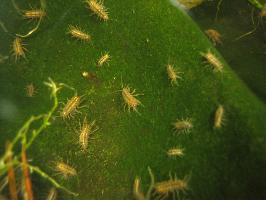
Poids et mesures
| Longueur | de 8 à 13 mm |
|---|
Description de l'animal
The Pond Slater, scientifically known as Asellus aquaticus, is a fascinating freshwater crustacean that thrives in a variety of aquatic habitats. This intriguing creature is a member of the Isopoda order, which is a group known for their flattened bodies that allow them to navigate through narrow spaces in their aquatic environments. The Pond Slater, in particular, has adapted perfectly to life in still or slow-moving waters, such as ponds, lakes, ditches, and calm streams, making it a common yet captivating sight in such ecosystems.One of the most distinctive features of Asellus aquaticus is its dorsoventrally flattened body, which is not only an adaptation to its environment but also gives it a somewhat prehistoric appearance. The body is segmented and typically ranges in color from grey to brownish, sometimes with a hint of green, allowing it to blend seamlessly with the muddy or rocky substrates it often inhabits. This coloration serves as an effective camouflage, protecting it from predators.
The Pond Slater can grow up to about 12-14 millimeters in length, with males generally being slightly smaller than females. Its body is divided into three main parts: the head, thorax, and abdomen. The head houses two compound eyes and two pairs of antennae, which are crucial for navigating and sensing its environment. The thorax is composed of seven segments, each with a pair of legs, making for a total of 14 legs. These legs are not only used for locomotion but also assist in feeding. The abdomen, though shorter, plays a vital role in respiration and reproduction.
An interesting aspect of Asellus aquaticus is its mode of respiration. This creature breathes through its pleopods, which are specialized appendages located on the underside of its abdomen, effectively functioning as gills. These pleopods extract oxygen directly from the water, a process that is facilitated by the Pond Slater's constant movement, ensuring a steady flow of water over its respiratory surfaces.
Diet-wise, the Pond Slater is omnivorous, feeding on a variety of organic matter. Its diet includes dead and decaying plant material, algae, and detritus, as well as small invertebrates. This dietary flexibility makes it an important component of the aquatic food web, acting as both a scavenger and a source of food for larger predators.
Reproduction in Asellus aquaticus involves direct mating, where the male clasps the female with his specialized pereopods (legs) to transfer sperm. The female then carries the fertilized eggs in a brood pouch until they hatch, emerging as miniature versions of the adults. This reproductive strategy not only ensures the safety of the eggs but also allows for a rapid increase in population under favorable conditions.
Despite their small size and seemingly mundane existence, Pond Slaters play a crucial role in the aquatic ecosystems they inhabit. They contribute to the breakdown of organic matter, recycling nutrients back into the ecosystem, and serve as a food source for a variety of fish and amphibians. Their presence and abundance can also serve as indicators of water quality, making them an important species for ecological studies.
In conclusion, the Pond Slater, Asellus aquaticus, is a remarkable creature that exemplifies the complexity and interconnectivity of aquatic ecosystems. Its adaptations to life in freshwater environments, coupled with its role in nutrient cycling and the food web, underscore the importance of even the smallest organisms in maintaining ecological balance.
Nouvelles photos d'animaux
Top 10 des animaux
- Dolphin gull (Leucophaeus scoresbii)
- Diana monkey (Cercopithecus diana)
- Moustached guenon (Cercopithecus cephus)
- Galápagos tortoise (Geochelone nigra complex)
- Russian tortoise (Testudo horsfieldii)
- Stone loach (Barbatula barbatula)
- Japanese macaque (Macaca fuscata)
- Greek tortoise (Testudo graeca)
- Common flying dragon (Draco volans)
- Vendace (Coregonus albula)